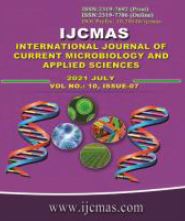


 National Academy of Agricultural Sciences (NAAS)
National Academy of Agricultural Sciences (NAAS)

|
PRINT ISSN : 2319-7692
Online ISSN : 2319-7706 Issues : 12 per year Publisher : Excellent Publishers Email : editorijcmas@gmail.com / submit@ijcmas.com Editor-in-chief: Dr.M.Prakash Index Copernicus ICV 2018: 95.39 NAAS RATING 2020: 5.38 |
Milk is a complete diet containing all essential nutritional constituents which have special significance in terms of properties such as protein, fat, mineral, vitamins and other ingredients dispersed in water. According to FDA (Food and Drug Administration), milk is recommended to be kept under refrigeration at or below 4 ͦ C to increase its shelf life period. Processes like pasteurization eliminates pathogenic microorganisms and also has significant effects on physical and chemical properties of milk. Microbial contamination might generally occur within the udder and exterior to the udder and also from the storage equipment used while milk handling. Some of the pathogenic bacteria that are generally isolated from milk are E.coli, Proteus vulgaris, Klebsiella, Pectobacterium, Citrobacter koseri, etc. Therefore the present study concedes to identify the total bacterial load along with the total content of protein, carbohydrate, fat, calcium etc. in unpasteurized open milk and pasteurized branded milk samples. The study was aimed to evaluate the extent of microbial contamination, physical and chemical properties of milk and its hygienic quality. Through the various physico-chemical and biochemical tests applied, it was ensured that the milk samples were of satisfactory quality and thus fit for human consumption.
 |
 |
 |
 |
 |